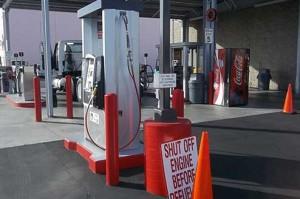Replacing common myths with the top 5 truths about natural gas safety
When it comes to natural gas fleet safety, there are many misconceptions. Most are because of a lack of understanding about how natural gas vehicles work, how fuel tank systems are designed and the safety features engineered into vehicles.
Like many of the drivers who attend safety training sessions, you may be surprised to learn not only are natural gas vehicles not explosives on wheels, but natural gas is one of the safest transport fuels around. What’s more, driving a natural gas vehicle confers many of unexpected benefits.
The vehicles are safe, quiet and run clean. There is no exhaust emerging from the tailpipe nor unpleasant diesel odors. Many drivers find that driving an automatic transmission truck can make navigating tricky urban traffic a far more enjoyable experience than anticipated.
So, let’s forget the myths and consider the top five truths about natural gas fleet safety:
- Truth 1: natural gas fuel systems are built for safety
In fact, an extremely high level of sophistication and functionality in terms of safety is engineered into the engine design and components of the fuel systems themselves. - Truth 2: natural gas tanks pass through rings of fire to be safety-certified
Getting a compressed natural gas tank certified for safety of operation is not an easy task. Natural gas fuel tanks must undergo rigorous testing to be certified. Those tests include placing gas tanks in a fire, increasing pressure to test the relief device that allows the gas to evacuate rather than explode, and dropping the tanks from 40 feet off the ground to ensure that they can resist impact and won’t burst if penetrated. - Truth 3: sophisticated detection systems protect vehicles
One of the most common worries about natural gas vehicles has to do with leaks. Actually, natural gas is a naturally occurring product made up primarily of methane. In its natural state, it’s odorless. However, for practical purposes, it’s odorized to enable easy leak detection.According to an article on safety in the Natural Gas Vehicle Knowledge Base, the average person can detect the odor at concentrations as low as 0.3%. For combustion to occur, natural gas requires a concentration between 5% and 15%. In other words, a driver will detect the smell long before combustion conditions are met. In addition to relying on smell, Ryder natural gas vehicles are equipped with gas detection equipment under the hood and in the cab of the truck.Another common concern is pressure. Because natural gas is stored at high pressures, many believe that this pressure makes it more hazardous than other fuels. However, if there is a leak, the high pressure actually forces gas to escape rapidly, reducing the likelihood of ignition. To prevent issues with leaks, pressure or component failures, natural gas vehicles are equipped with detection systems that include:- Sensors under the hood and in the cab designed to sense natural gas leaks and alert drivers through both audible and visual alarms
- Pressure gauges on fuel tanks indicating when pressure starts to rise
- Visual indicators that train drivers to recognize potential problems during pre-trip inspections
- Truth 4: Safety is factored into every aspect of the vehicle
Natural gas fuel tank systems and vehicles are designed so that no component is ever pushed to its limit.To prevent over-pressured systems, automatic safety mechanisms make sure pressure releases through devices before it gets too high. Also, standard safety factors are built into all components used and vehicle systems to alert drivers to issues with tires, lights, steering and more during pre-trip inspections. - Truth 5: With proper training, refueling is safe
While refueling a liquefied natural gas (LNG) vehicle requires certain precautions and personal protective equipment (PPE), trained drivers are fully capable of safely refueling vehicles.LNG fuel is a cryogenic liquid that’s cooled to -360 degrees Fahrenheit. Drivers are required to wear PPE at the pump such as cryogenically rated aprons, elbow length gloves and face shields. They’re also trained to use grounding wires to prevent static surges that could stimulate ignition.
Travis is Director of Safety and Loss Prevention for Ryder System, Inc. and a Certified Safety Professional (CSP). He’s a safety expert with 10 years of experience in Occupational Safety & Health, Transportation Safety and Risk Control practices. Throughout his career, Travis has implemented and operated thousands of solutions for customers across a variety of industry segments.

